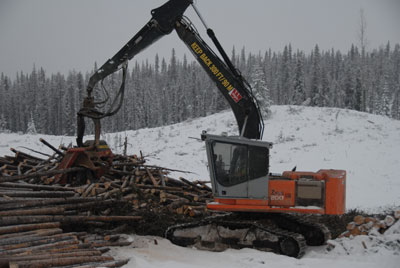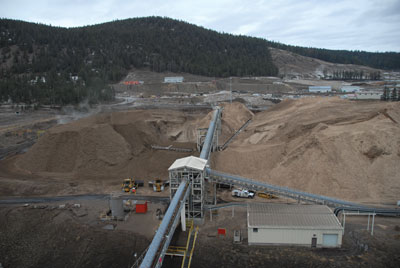
Could Less Mean More?
August 13, 2012
By Robin Brunet
Michael Weedon, executive director of the Vancouver-based B.C. Bioenergy Network, greets newcomers while clutching a copy of a presentation he authored, Partnering for a Green Future.
Michael Weedon, executive director of the Vancouver-based B.C. Bioenergy Network, greets newcomers while clutching a copy of a presentation he authored, Partnering for a Green Future. Ask him a question about the bioenergy sector, and he’ll riffle through it for facts supporting his answer.
 |
|
| Waste and breakage left behind processing beetle kill wood is a productivity cost for conventional operators but can be an opportunity for the biomass market, if access and ownership can be resolved.
|
The presentation, which was published last November, is an overview of what’s happening with bioenergy generation in British Columbia. It also serves to assuage fears about bioenergy’s future in the wake of the bad news of April, when it was disclosed that the Interior’s Annual Allowable Cut (AAC) would drop from 60 million cubic metres to 40 million within the next 13 years.
Sitting in the Network’s boardroom with the report open before him, Weedon remarks, “certainly the cutbacks will have enormous impact on sawmills and other components of B.C.’s logging industry. But for us, the fact of the matter is that the size of our wood pellet sector – to take just one example – could be doubled based on what’s in the woods.”
The 170-page “B.C. Mountain Pine Beetle: Evolving Impacts & Opportunities (to 2031)” co-authored by International Wood Markets Group president Russell Taylor, states that the Interior is nearing its peak economic saw log availability and that lumber and veneer production will decline beyond 2014, with the annual allowable timber harvest falling from 60 million cubic metres to 40 million by 2020-25. It also states that despite over 22 mills having closed in the Interior since 2005, few of them are likely to reopen due to lack of available timber – and some of the 66 remaining mills in the province will face more pressure from curtailment and/or closures in the near future.
The report’s findings coincide with a B.C. forests ministry document leaked in April, “Mid-Term Timber Supply Project,” which predicts that the Lakes district’s AAC will drop from two million cubic metres currently to 500,000 once the beetle wood becomes unusable, and forest employment will drop from 1,572 jobs before the beetle epidemic to 521. Prince George’s harvest total will drop by almost half, and the economically viable supply of dead pine in the Quesnel region could last for as little as another 18 months.
 |
|
| With the Annual Allowable Cut dropping, biomass accessibility could face troubled times. |
Weedon believes the ultimate outcome of the Interior cutbacks will be a substantially smaller industry – but not one that is detrimental to the bioenergy sector. “In fact, it will probably be more aligned than ever to our goals, with the overall objective of using every part of a tree and leaving very little if anything behind on the forest floor subject to biodiversity needs and good reforestation practices,” he says. “Granted, current economics make it unfeasible to take this approach, but the industry is steadily moving in the direction of a totally integrated approach to forestry – and more cutbacks will only speed the process.”
Doug Routledge, vice-president of forestry and northern operations for the Council of Forest Industries, agrees that “recent developments in the economic viability of non-saw log products are increasingly allowing us to adopt a full-fibre forest management mentality, whereby the portions of trees we harvest that can't be made into traditional lumber and veneer products can be used for new biomass-related products such as pellets, heat and energy, and the newly emerging product area of biofuels.”
Routledge goes on to say that most of the inventory and timber supply analysis in B.C. has had saw logs in mind. “But when one considers the portions of trees that are harvested but are non-saw log and so not in the current inventory figures, there’s a significant amount of material potentially available for the biomass subsector while still leaving sufficient woody debris behind on the forest floor to meet environmental objectives.”
This optimistic view is echoed in the International Wood Markets report. It says of the huge supply of biomass, “If new businesses can afford the cost of the fibre, then new opportunities may develop. In addition, several regions of the province are not impacted by the mountain pine beetle and significant volumes of fibre remain under-utilized, including the Peace and West Prince Rupert regions in the Interior.”
But these are blanket statements.
Gordon Murray, executive director of the Wood Pellet Association of Canada (WPAC), is more concerned with specifics, and he calls the AAC reductions a huge problem coming down. “In the short term we’re reliant on the cheapest fibre from sawmills, then the next option is procuring the harvest residuals, which is indeed voluminous but more costly. After that we’re faced with harvesting standing round wood – and nobody I know can make that pay, at least not yet.”
Murray adds, “the explosion that destroyed the Babine sawmill in Burns Lake definitely impacted our sector, so just imagine the problems more sawmill closures will cause. Hopefully, some mills will come back on line thanks to our improving economy and trade with China – but we can’t base our future on something so tenuous.”
Also tenuous is the longevity of the biomass that experts believe is in so much abundance. “We predict it will all be used up by mid-next decade,” notes Taylor. “There will be fibre shortages on a regional level for existing plants that use biomass.”
Robert Gray, fire ecologist for Chilliwack-based R.W. Gray Consulting Ltd., has a slightly different view of biomass supply. He thinks that climate change, insect epidemics, drought and wildfires threatening forests will result “in the necessity of landscape-scale intervention in the form of thinning and restoration, and the only market outlet for the majority of this material is bioenergy.”
But Gray is discouraged that government hasn’t done more to ensure that current or future biomass is accessible to users. Considering the NDP could be voted into power next year, how would he inspire policy-makers?
“The issue suffers from a couple of key problems, one being a general lack of accurate data on biomass supplies and the economics of accessing it,” he replies. “To move this forward we need to build a solid business case, engage the existing industry, and play the political game. Engaging industry means finding those players that are willing to actively work with new enterprises and demonstrating the strength of those arrangements to the elected officials.”
 |
|
| Few sawmills have yet closed in the Williams Lake area, but it will be hard hit, perhaps opening up more affected fibre for bioenergy uses at facilities like the massive Capital Power LP Williams Lake biomass power plant.
|
For his part, Weedon prefers not to dwell too heavily on the fibre debate triggered by the International Wood Markets report. “Fibre has been an easy hit for us up until recently,” he says. “We need to look at other things too if we are to sustain and grow our industry.”
Weedon uses examples in his presentation to reinforce the argument that the B.C. Bioenergy Network can evolve further with help from what he calls underutilized waste streams.
“For example, we invested $1.5 million in a pilot project with Paradigm Environmental Technologies, which is taking sludge from Catalyst Paper Corp.’s pulp and paper mill in Crofton and using anaerobic digesters to turn it into methane. The pilot is nearing completion and so far the results are promising.”
Not surprisingly, Weedon also strongly supports the development of torrefied wood processes. “This has great potential in B.C., partly because it’s an ideal opportunity to use the stands destroyed by the pine beetle. Plus, the torrefied materials can be densified into pellets or briquettes, which have the energy density of coal, can be produced to be resistant to water and therefore wouldn’t require specialized transport or storage like wood pellets do. So far, three small producers in this province are making torrefaction fuels and about six other companies are contemplating investment in torrefaction technology.”
Other innovative B.C. bioenergy endeavours outlined in Partnering for a Green Future include Nexterra, which is using a thermo chemical process to turn woody biomass into clean syngas to produce electricity, and International Composting Corporation which is transforming lawn, garden and food waste into a clean, synthetic biodiesel. “There’s no single magic bullet to replace petroleum, so we have to develop processes that produce a variety of energy forms,” says Weedon. “This naturally means that in addition to solid wood and forest residuals, we need to use low-cost feed stock like municipal biosolids, wastewater, landfill gases, and agricultural animal and crop wastes.”
Murray agrees – to a point.
“Yes, there are lots of interesting projects and proposals,” he says. “The one that really intrigues me is the prospect of purpose-grown crops such as fast-growing willows being planted on private lands or sites not suitable for saw logs located near processing facilities,” he says. “Lots of attention is being paid to this strategy globally because it solves the problems of economical access and transportation, and I’m sure we’ll give it a shot after it’s tried out in the U.S. or Brazil. However, for the time being we’ll continue to be reliant on the primary sector to secure raw material, and on that score more sawmills will reduce capacity or close.”
He concludes by saying that sawmills will continue to close, no matter what. “That said, they won’t close all at once, and as each one closes there will be a lot of hand wringing while we’ll get more of the residuals and push up the price of our products as much as possible in Europe. The bottom line is we’ll manage. We’re in a tough industry in which a pellet will never be as valuable as a board foot of lumber – so we have to work doubly hard to make it viable.”
Print this page